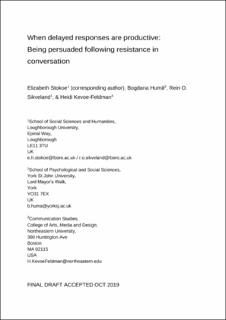| dc.contributor.author | Stokoe, Elizabeth | |
| dc.contributor.author | Huma, Bogdana | |
| dc.contributor.author | Sikveland, Rein Ove | |
| dc.contributor.author | Kevoe-Feldman, Heidi | |
| dc.date.accessioned | 2021-02-12T11:33:38Z | |
| dc.date.available | 2021-02-12T11:33:38Z | |
| dc.date.created | 2020-01-13T17:36:50Z | |
| dc.date.issued | 2020 | |
| dc.identifier.citation | Journal of Pragmatics. 2020, 155, 70-82. | en_US |
| dc.identifier.issn | 0378-2166 | |
| dc.identifier.uri | https://hdl.handle.net/11250/2727715 | |
| dc.description.abstract | Conversation analysts have long since demonstrated that, in responding to an initiating action (e.g., question), recipients have at least two ways to respond; response options (e.g., answer, non-answer) are not equivalent, and ‘preferred’ responses are typically delivered more rapidly than ‘dispreferred’ responses. This paper examines cases in which ‘preferred’ responses, which progress the preceding actions in productive alignment, are delayed. We combined and analysed four British and American English datasets: mediators talking to potential clients; police negotiators talking to suicidal persons in crisis; calls to emergency services from suicidal persons, and salespeople talking to potential customers. Our analysis revealed that, when one party has resisted the project of the other, delay may indicate an upcoming productive response. Such delays break the sequence's contiguity, thus producing (some) structural independence from a previously dismissed course of action and enabling the speaker to maintain (some) ‘face’, in Goffman's terms. We discuss the implications of these findings for understanding alignment and preference in conversation analysis, and the practices of resistance and persuasion more generally. | en_US |
| dc.language.iso | eng | en_US |
| dc.publisher | Elsevier | en_US |
| dc.rights | Attribution-NonCommercial-NoDerivatives 4.0 Internasjonal | * |
| dc.rights.uri | http://creativecommons.org/licenses/by-nc-nd/4.0/deed.no | * |
| dc.title | When delayed responses are productive: Being persuaded following resistance in conversation | en_US |
| dc.type | Peer reviewed | en_US |
| dc.type | Journal article | en_US |
| dc.description.version | acceptedVersion | en_US |
| dc.source.pagenumber | 70-82 | en_US |
| dc.source.volume | 155 | en_US |
| dc.source.journal | Journal of Pragmatics | en_US |
| dc.identifier.doi | 10.1016/j.pragma.2019.10.001 | |
| dc.identifier.cristin | 1771822 | |
| dc.description.localcode | © 2019. This is the authors’ accepted and refereed manuscript to the article. Locked until 4 November 2020 due to copyright restrictions. This manuscript version is made available under the CC-BY-NC-ND 4.0 license http://creativecommons.org/licenses/by-nc-nd/4.0/ | en_US |
| cristin.ispublished | true | |
| cristin.fulltext | postprint | |
| cristin.qualitycode | 2 | |

